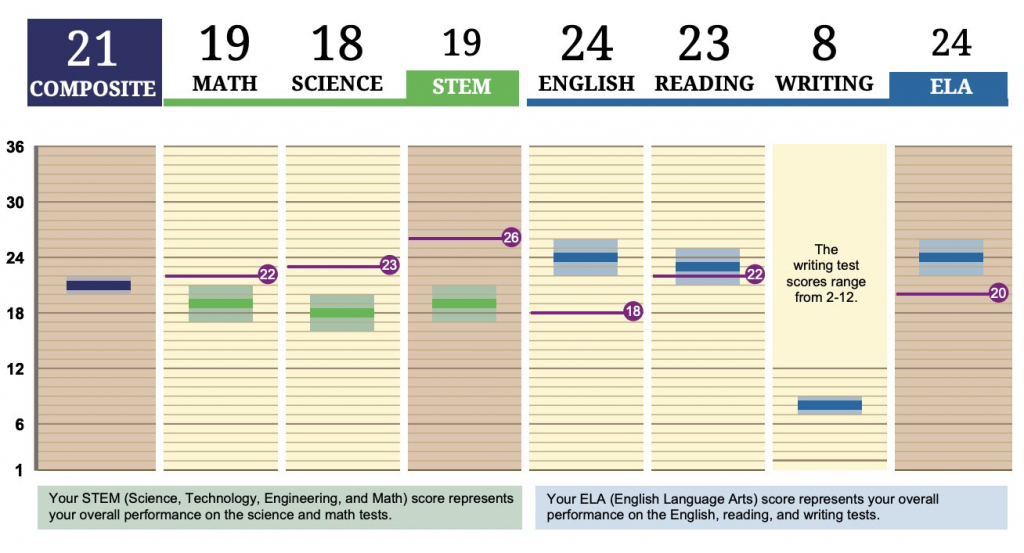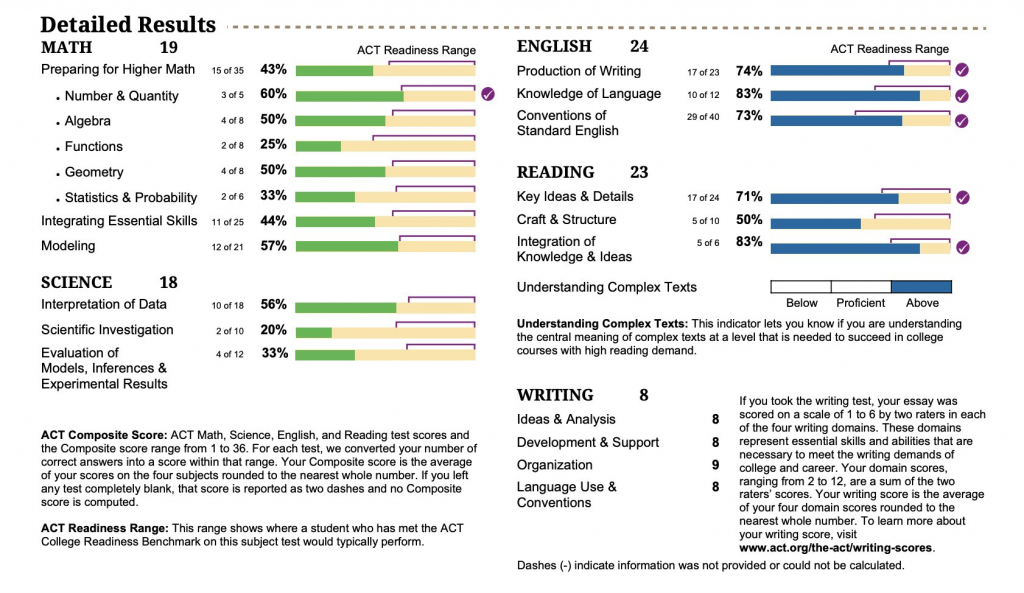By IvyWise Master Tutor
The most important piece of information that students will receive after taking the ACT is their Score Report. The ACT Score Report is multi-faceted, and contains information that not only lets students know how they did but also understand their specific and relative strengths and weaknesses to help guide their preparation for the next test sitting. So how can students and parents use this information to improve their scores in the future?
ACT Score Reports have been specifically geared to give as much context as possible for students’ performance, providing national ‘benchmark’ averages as well as identifying and suggesting possible major or academic areas of focus for students to pursue at the university level. There’s a lot of information that students, parents, and tutors can use in these Score Reports to help better focus test preparation moving forward in order for students’ to reach their goal scores.
The Basics
This is the portion of the ACT Score Report that students will first see — a composite score set as a banner to the top left, along with a breakdown for each specific section score. The ACT takes the number of questions answered correctly per section, applies them to a scoring scale which can vary for each official test, and converts the student’s raw score into a scaled score, ranging from 1 to 36, for each of the four specific sections. The composite score is simply the average of these four section scores.

Source: ACT
The ACT College Readiness Benchmarks included with the scores relate to the ACT’s proprietary assessment of how a student’s score in a specific section may correlate to their first-year performance in college in the corresponding area of study.

Source: ACT
The student will also find the above graphic in the score report, placing their score in the context of national and state averages for each of the different sections — STEM and ELA percentages are combined averages of the Mathematics and Science score and the English, Reading, and Writing score, respectively.
There is one key issue with the score report that should be addressed here: The STEM figure in the score report perpetuates, unfortunately, one key misconception regarding the ACT — that the Science and Math sections test similar skills. In fact, the Science section is more similar to the Reading section than the Mathematics section, and should be prepared for as such, a point that the test makers of the SAT test took note of in merging science and reading into one combined section. However, since the Science section of the ACT will be optional as of spring 2025, only the students who opt to take that section will have to worry about this.
Further down in the score report is where students can find a very helpful breakdown of their performance in each section, with each section broken down into categories for each type of question.
The Fine Print
This is easily the most important component of the score report. The Detailed Results graphic indicates how many questions make up each section and the student’s percentage of correct answers according to each question category. Each of these categories correspond to what the ACT believes are the essential composition abilities that will be required of any student’s first year university career.

Source: ACT
This graphic really helps the student visualize which section would be best served in terms of preparation. Each of the subcategories for each section correlates to certain and recurring types of questions and answer choices, so this graphic is really key for honing in on specific weaknesses, and should help guide students to make the best decision in terms of preparing for the next ACT test date, both in terms of what concepts to review and practice as well as how long to prepare.
For example, the Math section’s subcategories in ‘Geometry’ and its more cryptic cousin, ‘Modeling,’ points to the fact that the math section heavily tests the visual representation of data, shapes, and trends; lower percentages in these areas indicate that a student would be best served working on questions that require analyzing figures or drawing in further lines or shapes in an existing diagram.
This is where having a strong understanding of the ACT Score Report’s results and how to apply them to future test preparation is important. At IvyWise, our expert tutors help students reach their score goals by evaluating their score report and identifying potential areas of improvement in order to develop a customized tutoring plan and schedule to ensure that students make the best use of their time between test sittings.
It’s important to note that the writing score is not factored into the main composite score, nor is it factored into any of the other four subscores. The writing score is, however, is taken as part of the ELA figure given as part of the score report. The writing essay test is graded by two raters who each score the essay from 1-6 in each of the four writing categories shown in the graphic. The two scores are then added up to yield a combined score out of 12.
Next Steps
It’s important to keep in mind that the ACT score report is designed to address the following questions a student may have: Do the student’s scores accurately represent their academic abilities? Do the student’s scores adequately correlate to the their performance in school in the related areas covered on the test? What sort of preparation and review work will be required to make the necessary improvements for the next test sitting? Most students choose to take the ACT test multiple times, which makes the score report a highly useful asset for future preparation.
Students and parents should take time to evaluate ACT Score Reports and develop a plan for future test preparation and strategy. At IvyWise, we work with students to create a customized test prep plan in order to help them quickly and efficiently reach their goal scores on the ACT and SAT.
On average, students who complete 40 or more hours of tutoring with an IvyWise tutor increase their ACT scores by six points, but we have seen committed students raise their scores by 14 points! The average SAT score improvement is 200 points with some IvyWise students increasing their scores by 650 points.
For more information on IvyWise’s Test Prep services, contact us today.
Want to see how your ACT score compares to the SAT? Check out our score conversion chart.







